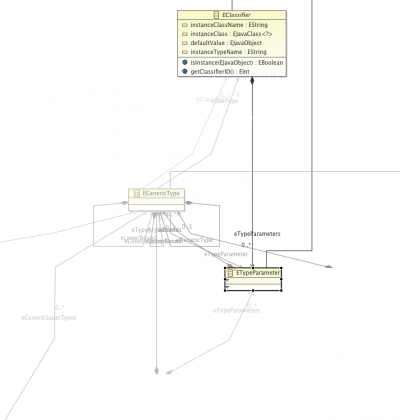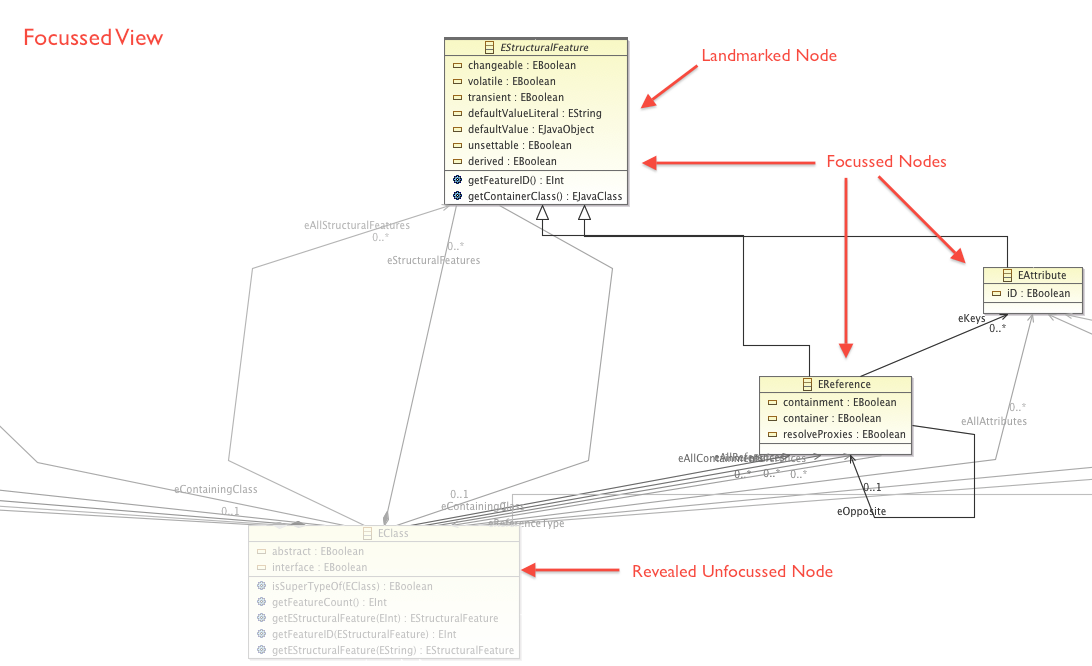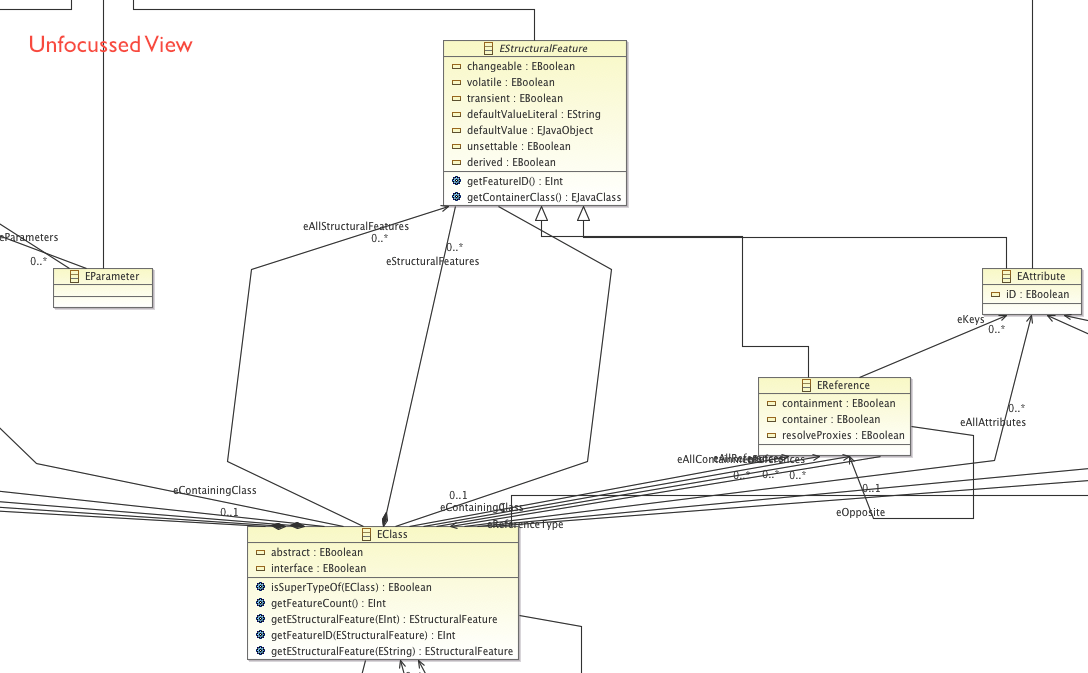Notice: This Wiki is now read only and edits are no longer possible. Please see: https://gitlab.eclipse.org/eclipsefdn/helpdesk/-/wikis/Wiki-shutdown-plan for the plan.
Mylyn/Context/Modeling Bridge
Currently, Mylyn for Modeling supports EcoreTools diagrams and Project Manager integration as well as Papyrus UML2 class diagrams. The supporting modeling bridge is designed to be relatively easy to extend to support arbitrary GMF supported diagram editors.
This work is developed by Tasktop Technologies and sponsored by Ericsson in the context of the Modeling Platform Industrial Working Group
Watch Mylyn for Modeling in Two Minutes (Screencast).
Contents
Users
Installing
- Current Release
-
http://download.eclipse.org/mft/drops/0.9.1/I20120907-1845(Recommended) - Snapshots
-
http://download.eclipse.org/mft/snapshots/juno/
- Previous Release (0.9.0)
-
http://download.eclipse.org/mft/drops/0.9.0/I20120314-1750/
You can also install MFT 0.9.0 from Juno, but the latest release is currently only available on the above site(s). SR1 will include 0.9.1.
We recommend starting with Ecore Tools, as the tools have less dependencies and more complete integration. Mylyn for Modeling has minimal dependencies defined on its target tools, so you should probably install the target tools separately if you don't already have them.
User Guide
Mylyn for Modeling works in the same way as other Mylyn tool integrations such as for Java. See the Mylyn User Guide for more details. Modeling specific features are described here.
Task-Focused Interface
Diagrams
To reveal unfocussed items, we provide a "fade effect" to reveal diagram items. As you move the mouse though the diagram, nearby unfocussed nodes and edges will be revealed. Just click on a node to add it to your current context.
Unselecting the ![]() Focus Button in the toolbar will cause all model elements to be shown as they are in an non-Mylyn enable editor.
Focus Button in the toolbar will cause all model elements to be shown as they are in an non-Mylyn enable editor.
To landmark a node, right-click on it and select "Mark as Landmark". Remove an element using "Remove Model Element from Context". Remove the entire diagram from the active context by clicking "Remove from Context".
Project Explorer
If you're working with EcoreTools or other supported EMF-based models you can also use "Alt-Click" in the Project Explorer to reveal and select nodes. This works for both model and diagram elements.
Tip: You can use the Outline View to help identify and navigate to the nodes you've revealed.
Developers
We've tried to design the modeling bridge so that it is easy to make your own GMF and other EMF-based editors and views Mylyn savvy. There are a number of artifacts to take care of but much of it is boiler-plate. (It would be straightforward to support this with a simple meta-model and code generation -- let us know if you'd like to participate in or support that effort!) And please let us know if you have any difficulties or improvements for the below steps.
Concepts
Users aren't interested in the diagram objects, they're really interested in the underlying domain or model objects. In the Mylyn Java integration, for example, Java classes and methods are tracked, and then revealed in various ways in different editors. So for an EcoreTools model for example, we don't want or need to keep track of the diagram Node objects or any other reference in the various foo.gmf.. files for, we want the domain object itself, e.g. EClass, EPackage, etc.. in the corresponding foo.ecore resource. What we need to do is to define what the user might be interested (or not interested) in and then map that to the diagram editors and other editor types.
Integrating Mylyn for Modeling with custom GMF editors
Recipe
Copy Existing Project
The best thing to do is just start with one of the two existing projects. We'd recommend org.eclipse.mylyn.modeling.papyrus.ui. org.eclipse.mylyn.modeling.ecoretools.ui will give you some ideas about how to work with a more complex scenario.
Refactor Artifacts
Rename files and other artifacts with the appropriate names. For example in your GMF "Foo" Diagram tool:
- Uml2DiagramDecoratorProvider -> FooDiagramDecoratorProvider
- In Plugin.xml
<decoratorProvider class="org.eclipse.mylyn.internal.modeling.papyrus.Uml2DiagramDecoratorProvider">
Becomes:<decoratorProvider class="org.you.foo.FooDiagramDecoratorProvider">
- etc..
Define Model Specific Behavior
Here's where the non-boiler plate stuff is.
Structure Bridge
In FooStructureBridge, you'll define domain objects which should be managed by Mylyn. This is how it is implemented in UML2StructureBridge:
@Override
public Class<?> getDomainBaseNodeClass() {
return Element.class;
}
@Override
public Class<?>[] getDomainNodeClasses() {
return new Class[] { Classifier.class };
}
@Override
public Class<?> getDomainBaseEdgeClass() {
return Relation.class;
}
@Override
public Class<?>[] getDomainEdgeClasses() {
return new Class[] { Relation.class };
}
See DomainModelContextStructureBridge for API details .
Diagram Bridge
In FooUiBridge, you'll define diagrams and views which should be managed by Mylyn. In UML2UiBridge, the important bits are:
@Override
public boolean acceptsPart(IWorkbenchPart part) {
return part instanceof PapyrusMultiDiagramEditor;
}
@Override
public boolean acceptsViewObject(Object domainObject, Object part) {
if (domainObject instanceof Classifier) {
return part instanceof ClassEditPart;
}
if (domainObject instanceof Package) {
return part instanceof PackageEditPart;
}
//Edges
if (domainObject instanceof Relationship) {
return part instanceof ConnectionNodeEditPart;
}
return false;
}
See DiagramUiBridge for details.
Future Work
Below are some ideas for further improvements and extensions. Please feel free to add your own, and let us know if you'd like to contribute solutions to any of these.
Support other Model Editors
It's quite easy to implement editors for other model types. It would be great to have more examples.
EMF Tree Editors
Support for arbitrary EMF generated editors. See this bug.
Easier Integration with Generic GMF Models
Code generation for Mylyn enabled GMF and EMF tree-based based editors. Ideally this would be completely transparent, but it's very likely we would need a project for each generated GMF model diagram. This isn't really an issue as generating code is part of the GMF diagram creation workflow anyway. This is actually a relatively simple plumbing task, as we already have good example projects to build tempaltes from.
Show Focussed Collaborations
The current approach works well for object collaborations that are already close together or that are composed of several related clusters. Our intuition is that this will generally be the case. To the extent that focussed nodes are spread out across the diagram, the current approach will be less effective. Note that the situation is still much better than without Mylyn as in the default case, you'd have to find the other nodes of interest amidst all of the other diagram clutter! There are a number of approaches we might take to this issue:
- Use "signposts" where distant but off screen nodes are indicated.
- These signposts when clicked on could auto-navigate to the related distant node.
- Depict simple collapsed overview diagrams of just the focussed element collaborations either as an inset caption or a separate navigation view.
Community
MFT Implementations
MFT can easily be extended to support other modelling tools. Third-party implementations include:
Status
MFT Release Review has passed release review for 0.9.0. We've just released version 0.9.1, which improves support for Papyrus and contains other graphics related fixes and improvements to the extension mechanism.
Known Issues
- The Diagram editor outline view "Focus on Active" task button doesn't do anything. [1]
- When you select the "Remove from Context" context menu item in a diagram, the entire editor closes. [2]
- Items in containers -- for example Ecore packages -- are not revealed or hidden by MFT, but the enclosing containers are. [3]
See all open bugs here: this link.
Communication
Please use: mylyn-context-dev.
Related Documents
- Blog Post by Miles Parker on the current effort.
- Blog post by David Green, Tasktop’s VP of Engineering, for model-driven development diagrams based on a model similar to, but not based on, EMF.
- Mik Kersten’s PhD thesis on Mylyn. See especially Section 5.4.1.





